Empathy is most often defined by the metaphors of 'standing in someone else's shoes' or 'seeing through someone else's eyes'. After combining and synthesizing the different ways the word is used, here are the four basic aspects of empathy that I have come up with. One way to think of it is as the wheel of empathy.
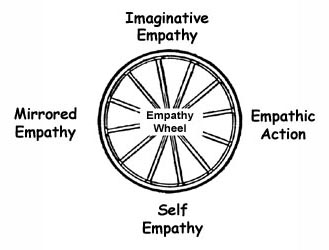
1. Self-EmpathyHow does compassion relate to empathy?
Mindfulness-sensory awareness of our own internal feelings and internal state.
Turning your attention inwards.
Getting connected with yourself.
Listening to your inner feelings and experiences.
Self-awareness and self-knowledge.
Meditation and mindfulness practices, for example, are good ways to foster self-empathy.
2. Mirrored Empathy
Emotional empathy of others via mirror neurons - reflecting others in ourselves and ourselves being reflected by others.
This is also called emotional or affective empathy.
Emotional contagion is when we catch the emotions of others.
3. Imaginative Empathy
Perspective and role taking of others.
Also called cognitive empathy.
This is based on the sense of self-awareness, when we recognize ourselves as separate beings.
4. Empathic Action
Once connection is created, taking creative action together.
Responding in an appropriate way to the other by holding their needs, values, feelings, (common humanity) etc. in mind in the action process.
Empathy is when the blocks to action are removed, that do not exclude.
Until an adequate level of self, mirrored and imaginative empathy are in place, empathic action may be blocked.
5. The Feel of EmpathyWhat does it feel like as a sensed body feeling? Warm, relaxed, open?
What is empathy like as a metaphor?
We can empathize with all the different feelings that someone may have; joy, sadness, caring, fear, loneliness, creativity, connection, grief, excitement, boredom, pain, suffering, etc etc. Compassion is the name applied to what happens when we empathize with pain and suffering. This can also be called empathic concern by some. It follows the same process as empathy. So compassion is a subset of the empathic process, it's empathy applied to suffering.
Self-CompassionMore DefinitionsScholars who study empathy have come up with at least 8 ways that the word is used.
Mirrored Compassion
Cognitive Compassion
Compassionate Action - the desire and action to alleviate the suffering, often with consoling.
8 Definitions of Empathy (from The Social Neuroscience of Empathy, These Things Called Empathy, Daniel Batson)
"The term empathy is currently applied to more than a half-dozen phenomena.
1. Knowing another persons internal state, Including thoughts and feelings
2. Adopting the posture or matching the neural responses of an observed other
3. Coming to feel as another person feels
4. Intuiting or projecting oneself into another's situation
5. Imagining how another is thinking and feeling
6. Imagining how one would think and feel in the other's place
7. Feeling distress at witnessing another person's suffering
8. Feeling for another person who is suffering (empathic concern) An other-oriented emotional response elicited by and congruent with the perceived welfare of someone in need. Includes feeling sympathy, compassion, tenderness and the like (i.e. feeling for the other, and not feeling as the other)"
Dan Batson delivers an address on "empathy-altruism hypothesis" at the 2007 Autonomy Singularity Creativity Conference.
He mentions his definitions starting at 10:00. | |
Dan Batson is Professor Emeritus at the University of Kansas. His main research interests are in prosocial emotion, motivation, and behavior. He has conducted a number of experiments on empathy, on perspective taking, and on various forms of prosocial motivation.
His chapter titled, 'These Things Called Empathy', in the book, 'The Social Neuroscience of Empathy', explores 8 ways the word and concept of empathy is used.Sub Conference: Science | ||
Dan Batson & Edwin Rutsch: Definitions of Empathy
I had an hour long conversation with Dan and we walked though his definitions step by step.
I had an hour long conversation with Dan and we walked though his definitions step by step.
Definition by Frans de Waal author of 'The Age of Empathy'

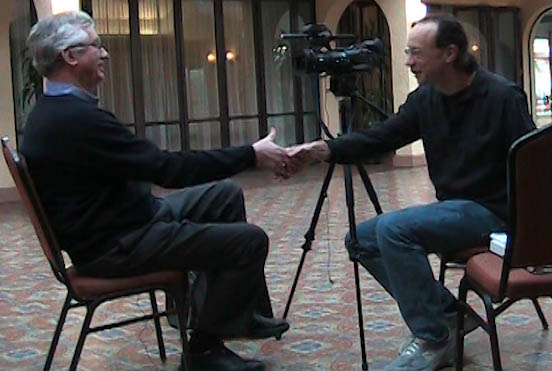
This definition by Frans De Waal uses the metaphor of the Russian Doll. Empathy is a layered process that parallels the layers of the brain. The most basic functions of the brain are found in many animal, then there are ever more higher layers that integrate with each other. The top layers are animals that have self-awareness like humans, dolphins, elephants, chimpanzees, etc.
What exactly is empathy? "Empathy: The capacity to
a) be affected by and share the emotional state of another,
b) assess the reasons for the other's state, and
c) identify with the other, adopting his or her perspective. This definition extends beyond what exists in many animals, but I employ the term "empathy" even if only the first criterion is met as I believe all of these elements are evolutionarily connected...."more.
The Antiquity of Empathy - Frans B. M. de Waal "The Russian doll model of multilayered empathy. The doll's inner core consists of the perception-action mechanism (PAM) that underlies state-matching and emotional contagion.Built around this hard-wired socioaffective basis, the doll's outer layers include sympathetic concern and targeted helping. The complexity of empathy grows with increasing perspective-taking capacities, which depend on prefrontal neural functioning, yet remain fundamentally connected to the PAM.
A few large-brained species show all of the doll's layers,
but most show only the inner ones."
Compassion & Empathy at Greater Good Science Center Wiki
"Strict dictionary definitions have a hard time separating the feelings of empathy, sympathy, compassion, and pity. Often these words are used to define each other. However research on the concepts has begun to pull them apart.
- Empathy is considered a mirroring or vicarious experience of another's emotions, whether they be sorrow or joy.
- Sympathy on the other hand, is a feeling of sorrow associated specifically with the suffering or need of another. These are examples of fellow-feeling, and they require a certain degree of equality in situation or circumstances.
- Pity which regards its object not only as suffering, but weak, and hence as inferior.
- Compassion is much like sympathy in that it stems from the suffering of another, but it also includes the need or desire to alleviate suffering" (Eisenberg, 2002).
Paul Ekman's Definitions
Daniel Golman credits Paul Ekman for his model of empathy which is three parts; cognitive empathy, emotional empathy and empathic concern. You can see my interview with Paul where we discussed his definitions.

Daniel Golman
Goleman points to the three types of empathy in the self-awareness domain. (I heard somewhere that he based this on the work of Paul Ekman. )
1. cognitive empathy. “This is about being able to understand how the other person thinks. Leaders who are good at this are able to express things in a way that impacts people, that reaches people effectively.57 Empathy Definitions Complied by Anita Nowak In her dissertation,
2. emotional empathy
3. empathic concern
Different Kinds of Empathy
Introducing A Pedagogy of Empathic Action As Informed By Social Entrepreneurs
2:50 From Emotional Contagion through Empathy to Compassionfrom Tania Singer - Breaking the Wall between People @Falling Walls 2010
This is a definition and model by Tania Singer. Starts in this video clip at around 2:50 min.
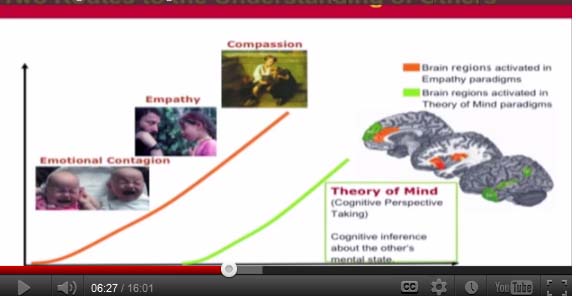
This is a definition and model by Tania Singer. Starts in this video clip at around 2:50 min.

- Emotional Contagion
- babies crying contagion
- baby laughing contagion - [video]
- eye pupil measurements of emotions - are also contagious
- see someone that is sad, you mirror it.
- unconsciously
- this is not yet empathy
- Empathy
- self other distinction
- differentiating my pain and your pain.
- people think empathy is a good thing,
- if you have too much empathy, like in caregiver profession, this can be a problem
- you can burnout
- you can turn it into compassion
- Compassion
- you can turn it into sympathy, compassion, concern for the other
- a real motivation for the welfare for the other
- a concern for the other
- a warm feeling
- Theory of Mind (TOM) - there are different routes into the brain/mind of another person
- Theory of Mind - a cognitive perspective taking
- not an affective root into the other but a cognitive route.
- Psychopaths for example have (TOM)
- good at manipulating others, know the others needs and beliefs are
- but they lack empathy
The first quality is empathy. Many people believe that this is the single quality which is most important in all forms of therapeutic listening. It means getting inside the world of the person who comes for therapy (usually called the client, though some people not in this group prefer other words such as patient or consulter) so that that person feels accepted and understood. Two things are important about this:
(1) that the empathy be accurate, and
(2) that the empathy be made known to the client.
Both of these are learnable skills, and they do make a huge difference to the relationship between client and counselor or therapist.
The second quality is genuineness. If empathy is about listening to the client, genuineness is about listening to myself - really tuning in to myself and being aware of all that is going on inside myself. It means being open to my own experience, not shutting off any of it. And again it means letting this out in such a way that the client can get the benefit of it. Genuineness is harder than empathy because it implies a lot of self-knowledge, which can really only be obtained by going through one's own therapy in quite a full and deep way. It is only a fully-functioning person (Rogers' word for the person who has completed at least the major part of their therapy) who can be totally genuine.
The third quality is non-possessive warmth. It means that the client can feel received in a human way, which is not threatening. In such an atmosphere trust can develop, and the person can feel able to open up to their own experiences and their own feelings.
EARLY DEFINITIONS: The state of empathy, or being empathic, is to perceive the internal frame of reference of another with accuracy and with the emotional components and meanings which pertain thereto as if one were the person, but without ever losing the "as if" condition. Thus it means to sense the hurt or the pleasure of another as he senses it and to perceive the causes thereof as he perceives them, but without ever losing the recognition that it is as if I were hurt or pleased and so forth. If this "as if" quality is lost, then the state is one of identification. (pp. 210—211. See also Rogers, 1957.)
A CURRENT DEFINITION: With this conceptual background, let me attempt a description of empathy that would seem satisfactory to me today. I would no longer be terming it a "state of empathy," because I believe it to be a process, rather than a state. Perhaps I can capture that quality.
An empathic way of being with another person has several facets. It means entering the private perceptual world of the other and becoming thoroughly at home in it. It involves being sensitive, moment by moment, to the changing felt meanings which flow in this other person, to the fear or rage or tenderness or confusion or whatever that he or she is experiencing. It means temporarily living in the other's life, moving about in it delicately without making judgements; it means sensing meanings of which he or she is scarcely aware, but not trying to uncover totally unconscious feelings, since this would he too threatening. It includes communicating your sensings of the person's world as you look with fresh and unfrightened eyes at elements of which he or she is fearful. It means frequently checking with the person as to the accuracy of your sensings, and being guided by the responses you receive. You are a confident companion to the person in his or her inner world. By pointing to the possible meanings in the flow of another person's experiencing, you help the other to focus on this useful type of referent, to experience the meanings more fully, and to move forward in the experiencing.
To be with another in this way means that for the time being, you lay aside your own views and values in order to enter another's world without prejudice. In some sense it means that you lay aside your self; this can only be done by persons who are secure enough in themselves that they know they will not get lost in what may turn out to be the strange or bizarre world of the other, and that they can comfortably return to their own world when they wish.Perhaps this description makes clear that being empathic is a complex, demanding, and strong - yet also a subtle and gentle - way of being.
To perceive the internal frame of reference of another with accuracy and with the emotional components and meanings which pertain thereto as if one were the person, but without ever losing the "as if" condition. Thus, it means to sense the hurt or the pleasure of another as he senses it and to perceive the causes thereof as he perceives them, but without ever losing the recognition that it is as if I were hurt or pleased and so forth.
Empathy is a respectful understanding of what others are experiencing. Instead of offering empathy, we often have a strong urge to give advice or reassurance and to explain our own position or feeling. Empathy, however, calls upon us to empty our mind and listen to others with our whole being.In nonviolent communication, no matter what words others may use to express themselves, we simply listen for their observations, feelings, needs, and requests. Then we may wish to reflect back, paraphrasing what we have understood. We stay with empathy, allowing others the opportunity to fully express themselves before we turn our attention to solutions or requests for relief.We need empathy to give empathy. When we sense ourselves being defensive or unable to empathize, we need to (A) stop, breathe, give ourselves empathy, (B) screamed nonviolently, or (C) take time out."
Current Disciplinary and Interdisciplinary Debates on EmpathyThis edition of the Emotion Review - January 2012 was focused on defining empathy. "A central question of this special section is how cognitive and affective dimensions do or do not cooperate in empathy."
"Empathy is a social feeling that consists in feelingly grasping or retracing the present, future, or past emotional state of the other; thus, empathy is also called a vicarious emotion"
Question: "What is the Definition for Empathy?"
Marshall Rosenberg: "Empathy, I would say is presence. Pure presence to what is alive in a person at this moment, bringing nothing in from the past. The more you know a person, the harder empathy is. The more you have studied psychology, the harder empathy really is. Because you can bring no thinking in from the past. If you surf, you'd be better at empathy because you will have built into your body what it is about. Being present and getting in with the energy that is coming through you in the present. It is not a mental understanding."
Question: "Is it speaking from the heart?"
Rosenberg: "What? Empathy? In empathy, you don't speak at all. You speak with the eyes. You speak with the body. If you say any words at all, it's because you are not sure you are with the person. So you may say some words. But the words are not empathy. Empathy is when the other person feels the connection to with what's alive in you."
The Terms of Empathy
What does "empathy" mean exactly, and how is it different from sympathy or other emotional experiences? Some scientists differ in how they use the term. Below is a list of definitions of empathy and related terms
- Emotional contagion:
- Empathy:
- Sympathy
- Cognitive empathy
Empathy is the capacity to recognize or understand another's state of mind or emotion. It is often characterized as the ability to "put oneself into another's shoes", or to in some way experience the outlook or emotions of another being within oneself. Empathy does not necessarily imply compassion, or empathic concern because this capacity can be present in context of compassionate or
"an understanding of and identification with the emotions of another person
Both empathy and the related word sympathy come from the Greek word pathos, "emotion." To say you empathize with someone is to say you feel their pain or emotions. If you are empathetic, you "put yourself in someone's place" and try to understand exactly how they feel. As Atticus Finch said in To Kill a Mocking Bird, "You don't truly know a man unless you have walked a mile in his shoes." That is empathy.
- Because she was once destitute herself, she has great empathy for the homeless. (compassion, sympathy)
- As a nurse, she does more than offer medical care; she provides empathy and comfort as well. (understanding, compassion)
- Experiencing the death of a close friend has allowed me to be more empathetic with other grieving people. (understanding) adjective
- He seems like a cold and heartless man; he has no empathy for others. (compassion, sympathy)"
"1. understanding of another's feelings: the ability to identify with and understand somebody else's feelings or difficulties
2. attribution of feelings to an object: the transfer of somebody's own feelings and emotions to an object such as a painting"
"Greek empatheia, literally, passion, from empathēs emotional, from em- + pathos feelings, emotion - more at pathos Date:1850
1: the imaginative projection of a subjective state into an object so that the object appears to be infused with it
2: the action of understanding, being aware of, being sensitive to, and vicariously experiencing the feelings, thoughts, and experience of another of either the past or present without having the feelings, thoughts, and experience fully communicated in an objectively explicit manner ; also : the capacity for this"
'Etymology: A twentieth-century borrowing of Ancient Greek ἐμπάθεια (empatheia), literally passion (formed from εν- en-, in, at + πάθος pathos feeling), coined by Rudolf Lotze to translate German Einfühlung. The modern Greek word εμπάθεια has an opposite meaning denoting strong negative feelings and prejudice against someone.
Empathy
1. the intellectual identification of the thoughts, feelings, or state of another person
2. capacity to understand another person's point of view or the result of such understanding'
'the ability to imagine oneself in another's place and understand the other's feelings, desires, ideas, and actions. It is a term coined in the early 20th century, equivalent to the German Einfühlung and modeled on "sympathy." The term is used with special (but not exclusive) reference to aesthetic experience. The most obvious example, perhaps, is that of the actor or singer who genuinely feels the part he is performing. With other works of art, a spectator may, by a kind of introjection, feel himself involved in what he observes or contemplates. The use of empathy is an important part of the counseling technique developed by the American psychologist Carl Rogers.'
'1. the intellectual identification with or vicarious experiencing of the feelings, thoughts, or attitudes of another.
2. the imaginative ascribing to an object, as a natural object or work of art, feelings or attitudes present in oneself: By means of empathy, a great painting becomes a mirror of the self.
Origin: 1900-05; < Gk empátheia affection, equiv. to em- em- 2 + path- (base of páschein to suffer) + -eia -ia; present meaning translates German - Einfühlung
1. understanding of another's feelings: the ability to identify with and understand somebody else's feelings or difficulties
2. attribution of feelings to an object: the transfer of somebody's own feelings and emotions to an object such as a painting
Identifying oneself completely with an object or person, sometimes even to the point of responding physically, as when, watching a baseball player swing at a pitch, one feels one's own muscles flex.
1. the intellectual identification of the thoughts, feelings, or state of another person
2. capacity to understand another person's point of view or the result of such understanding
Etymology: A twentieth-century borrowing of Ancient Greek á (empatheia), literally "passion" (formed from - en-, "in, at" + pathos "feeling"), coined by w:Rudolf Lotze, Rudolf Lotze to translate German Einfíhlung. The modern Greek word has an opposite meaning denoting strong negative feelings and prejudice against someone.
concord, accord, harmony, symphony, agreement, sympathy, union, unison, unity, unanimity, league, friendship, alliance, understanding, conciliation;
antonym: Discord
Etymonline.com
1903, translation of Ger. Einfühlung (from ein "in" + Fühlung "feeling"), coined 1858 by Ger. philosopher Rudolf Lotze (1817-81) from Gk. empatheia "passion," from en- "in" + pathos"feeling" (see pathos). A term from a theory of art appreciation. Empathize (v.) was coined 1924; empathic (adj.) is from 1909.
EMPATHIEA-"Empathy literally means the power of understanding things outside ourselves after the Greek empatheia, but has come to imply a reliance on inner feeling"
feeling into another individuals emotional state (einfuhlung)" Lipps 1903 -
"empathy involves resonating with other peoples unconscious affect" - feeling vibrations?
On Empathy: By: Dr. Sam Vaknin - The Encyclopaedia Britannica (1999 edition) defines empathy as:
"The ability to imagine oneself in an other's place and understand the other's feelings, desires, ideas, and actions. It is a term coined in the early 20th century, equivalent to the German Einfühlung and modeled on "sympathy." The term is used with special (but not exclusive) reference to aesthetic experience. The most obvious example, perhaps, is that of the actor or singer who genuinely feels the part he is performing. With other works of art, a spectator may, by a kind of introjection, feel himself involved in what he observes or contemplates. The use of empathy is an important part of the counseling technique developed by the American psychologist Carl Rogers."
Wikipedia: Theorists and their definitions
A motivation oriented towards the other. Daniel BatsonThe capacity to know emotionally what another is experiencing from within the frame of reference of that other person, the capacity to sample the feelings of another or to put oneself in another's shoes. D. M. BergerA sense of similarity in feelings experienced by the self and the other, without confusion between the two individuals. Jean DecetyAn affective response that stems from the apprehension or comprehension of another's emotional state or condition, and that is similar to what the other person is feeling or would be expected to feel. Nancy EisenbergTo empathize means to share, to experience the feelings of another person. R. R. GreensonThe ability to put oneself into the mental shoes of another person to understand her emotions and feelings. Alvin GoldmanAn affective response more appropriate to another's situation than one's own.Martin HoffmanA complex form of psychological inference in which observation, memory, knowledge, and reasoning are combined to yield insights into the thoughts and feelings of others. William IckesEmpathy is the capacity to think and feel oneself into the inner life of another person. Heinz KohutEmpathy involves the inner experience of sharing in and comprehending the momentary psychological state of another person. Roy Schafer"We recognize others as empathic when we feel that they have accurately acted on or somehow acknowledged in stated or unstated fashion our values or motivations, our knowledge, and our skills or competence, but especially as they appear to recognize the significance of our actions in a manner that we can tolerate their being recognized." Wynn SchwartzEmpathy is the experience of foreign consciousness in general. Edith SteinIn popular usage the idea refers to the emotional resonance between two people, when, like strings tuned to the same frequency, each responds in perfect sympathy to the other and each reinforces the responses of the other. A good example of this occurs in the statement: "Aleatoric concert music, like jazz, demands a strong empathy between performer and listener" (Houkom, p. 10).Empathy is about spontaneously and naturally tuning into the other person's thoughts and feelings, whatever these might be [...]There are two major elements to empathy. The first is the cognitive component: Understanding the others feelings and the ability to take their perspective [...] the second element to empathy is the affective component. This is an observers appropriate emotional response to another person's emotional state. Simon Baron-Cohen (2003):


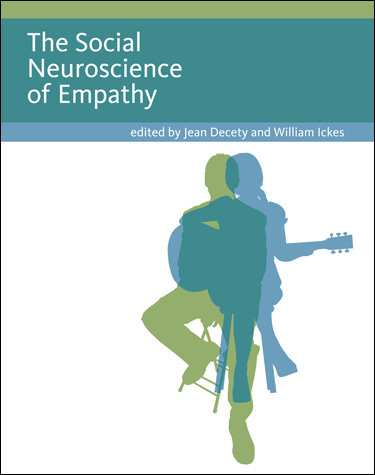
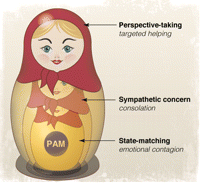
No comments:
Post a Comment